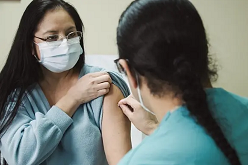
- Details
- By Tom Anderson
Guest Opinion. As a tribal citizen of the Cherokee Nation, I know firsthand how rich and cherished tribal cultures are - but, as with anything precious, our cultures' longevity depends on a concerted effort.
One dangerous risk facing our Tribal communities today is communicable disease, most notably influenza, also called the flu. This respiratory virus is incredibly contagious, causes mild to severe illness and can lead to serious complications or even death.
While influenza cases dropped sharply during the height of the COVID-19 pandemic — a trend that experts agree is most likely attributed to increased masking and social distancing —the seasonal flu returned with a vengeance last year, resulting in a spike in cases impacting tribal communities. Leading epidemiologists believe there will be a surge in influenza cases again this year.
The uptick in positive influenza cases means it's vital for tribal members across the Indian Country to stay on top of their flu vaccinations.
AI/AN individuals are disproportionately affected by the flu.
According to the Centers for Disease Control and Prevention (CDC), flu and pneumonia rank among the top 10 leading causes of death among AI/ANs, and Indian Health Service (IHS) studies show that AI/ANs are more likely to be hospitalized due to the flu when compared to the general U.S. population.
The more recent data from the CDC suggests that seasonal flu activity is increasing in most parts of the country, specifically in the South Central, Southwest and West Coast regions. These regions have the highest numbers of American Indian populations when compared to the rest of the country, further increasing the risk of tribal citizens contracting the flu and subsequent damaging complications.
There are numerous benefits to getting the flu vaccine.
Help us ensure that the celebration of Native Heritage never stops by donating here.
The flu vaccine helps protect you, your family and others in your community from contracting the flu and any related complications. Babies and young children, Tribal elders and those immuno-compromised with chronic health conditions are at greater risk of contracting and developing complications from the flu.
Research shows getting the flu vaccination reduces the severity of the illness in people who have been vaccinated but still get sick. Vaccination has been proven to reduce complications related to other medical conditions, such as heart attacks and diabetes.
Finally, increasing flu vaccinations in Tribal communities helps safeguard tribal cultures and preserve them for future generations. When you receive the seasonal flu vaccine, you're protecting more than yourself - you're protecting valued traditions, important history and culture bearers who carry so much knowledge for our tribal families and communities.
Flu vaccines are safe, effective and widely available. With limited exceptions, everyone six months and older should get the annual flu vaccine. Contact your local Indian Health Service Clinic, physician, or pharmacy as soon as possible to make an appointment for the yearly flu vaccine.
For our cultures to continue to thrive for generations to come, consider taking the next step toward prevention by staying up to date with your flu vaccination.
Tom Anderson is the executive director of theAssociation of American Indian Physicians, a national association headquartered in Oklahoma City, Okla.
Help us tell the stories that could save Native languages and food traditions
At a critical moment for Indian Country, Native News Online is embarking on our most ambitious reporting project yet: "Cultivating Culture," a three-year investigation into two forces shaping Native community survival—food sovereignty and language revitalization.
The devastating impact of COVID-19 accelerated the loss of Native elders and with them, irreplaceable cultural knowledge. Yet across tribal communities, innovative leaders are fighting back, reclaiming traditional food systems and breathing new life into Native languages. These aren't just cultural preservation efforts—they're powerful pathways to community health, healing, and resilience.
Our dedicated reporting team will spend three years documenting these stories through on-the-ground reporting in 18 tribal communities, producing over 200 in-depth stories, 18 podcast episodes, and multimedia content that amplifies Indigenous voices. We'll show policymakers, funders, and allies how cultural restoration directly impacts physical and mental wellness while celebrating successful models of sovereignty and self-determination.
This isn't corporate media parachuting into Indian Country for a quick story. This is sustained, relationship-based journalism by Native reporters who understand these communities. It's "Warrior Journalism"—fearless reporting that serves the 5.5 million readers who depend on us for news that mainstream media often ignores.
We need your help right now. While we've secured partial funding, we're still $450,000 short of our three-year budget. Our immediate goal is $25,000 this month to keep this critical work moving forward—funding reporter salaries, travel to remote communities, photography, and the deep reporting these stories deserve.
Every dollar directly supports Indigenous journalists telling Indigenous stories. Whether it's $5 or $50, your contribution ensures these vital narratives of resilience, innovation, and hope don't disappear into silence.
 The stakes couldn't be higher. Native languages are being lost at an alarming rate. Food insecurity plagues many tribal communities. But solutions are emerging, and these stories need to be told.
The stakes couldn't be higher. Native languages are being lost at an alarming rate. Food insecurity plagues many tribal communities. But solutions are emerging, and these stories need to be told.
Support independent Native journalism. Fund the stories that matter.
Levi Rickert (Potawatomi), Editor & Publisher
